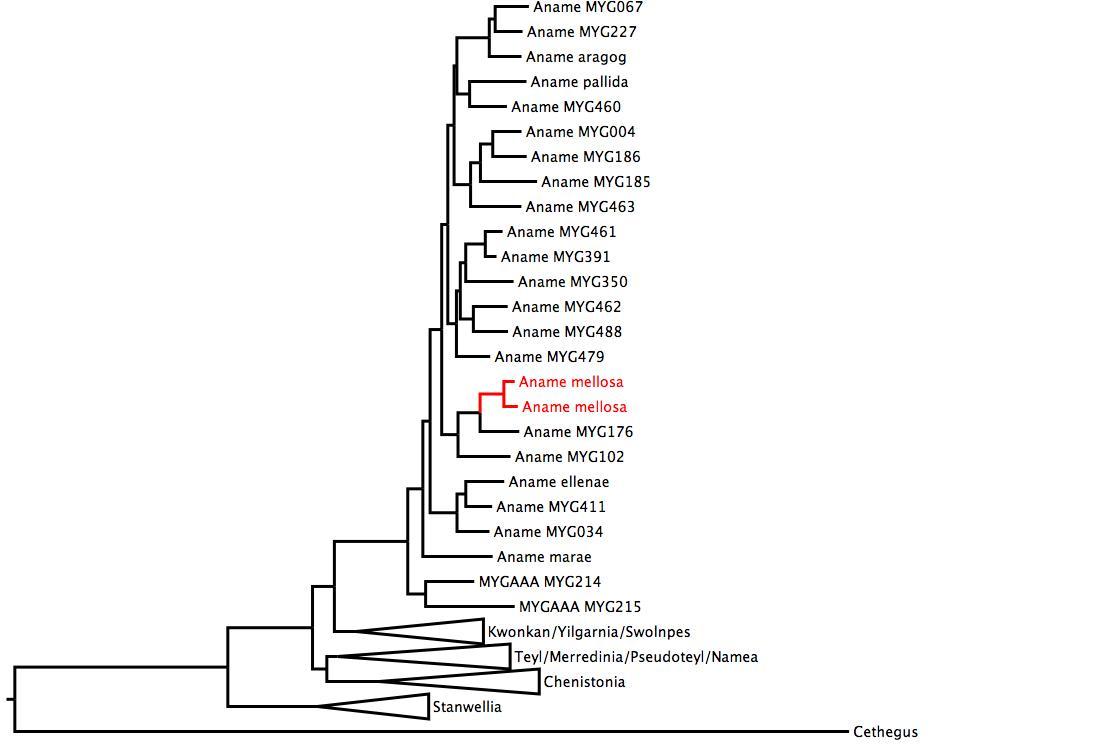Open-holed trapdoor spider
Aname mellosa
Mygalomorph spiders are more commonly known as trapdoor spiders, tarantulas and funnel web spiders. They are heavy set spiders, with downward facing fangs that they use to envenomate their prey. While they spin silk to line their burrows, they do not build elaborate capture webs like other groups of spiders. They are sensitive to desiccation and so many species live underground in burrows, or in wetter parts of the continent. Nemesiids build burrows and are rarely seen above ground. They have open holes (without a trapdoor), often with thin strands of silk around the opening. Australia’s most famous mygalomorph, the Sydney funnel-web spider (Atrax robustus) is not found in Western Australia, and many of WA’s less dangerous mygalomorphs are mistaken for this dangerous species.
Morphology
This species belongs to the genus Aname. The genus Aname is distinguishable from other genera in males by the presence of a small groove or depression in the male pedipalpal tibia. Species of Nemesiidae are often distinguished from each other using two main characters on adult males. First is the large spur found on the front legs, used to engage with the female during mating. Second, by the shape and size of the palps, the sexual organs males use to inseminate females during mating. Females are rarely distinguishable from each other, and there are no known genus level characters for female Aname.
Evolution
The Australian members of the Nemesiidae have a complex evolutionary history. Researchers at the WA Museum have recently resolved the relationships between the genera presented here using molecular tools and formal changes to the taxonomy are forthcoming, but further work is required to fully understand the species level diversity.
This genus, is strongly affilliated with the transitional and arid zones of Australia. It is believed they radiated into the arid zone as it formed 5-10 million years ago. Ongoing work using molecular clocks will test this hypothesis.
Behaviour
Very little is known about the behaviour of nemesiids.
Females reside in a single burrow for their entire life after hatching and leaving their natal burrow. In this burrow they store food, lay eggs and mate.
Males similarly reside in a single burrow for their entire lives but upon becoming sexually mature, they disperse from their home and seek out adult females in their burrows. Males do not return home but eventually die after mating or while seeking mates.
It is believed that individuals reside in a single burrow and if that burrow is disturbed or damaged, that they cannot rebuild a new burrow.
Method of reproduction
Sexual
Habitat
Terrestrial
Little is known about the specific habitat requirements of many nemesiids. They prefer undisturbed, unmodified landscapes, where they can build their burrows and persist during their long life spans. They are often displaced from locations with an overabundance of invasive weeds, or compacted soils from stock and/or plowing.
Distribution
Pilbara, Western Australia
Life Cycle
Juveniles hatch in the mother's burrow and disperse to build their own burrow.
Females will then remain in that burrow for their entire lives.
Males will disperse to find females when sexually mature.
Life spans are uncertain, but individuals could live more than ten years, and sexual maturity could be reached as early as 2-3 years.
| Kingdom: | Animalia |
|---|---|
| Phylum: | Arthropoda |
| Subphylum: | Chelicerata |
| Class: | Arachnida |
| Order: | Araneae |
| Suborder: | Opisthothelae |
| Infraorder: | Mygalomorphae |
| Family: | Nemesiidae |
| Subfamily: | Anaminae |
| Genus: | Aname |
| Species: | mellosa |
| Name Published Year: | 2012 |
|---|---|
| Rank: | species |
| Scientific Name Authorship: | Harvey et al. |
| Commercial Impact: | None |
| Conservation Assessment: | Least Concern |
Phylogenetic Tree:

Cite this page
Western Australian Museum Collections https://museum.wa.gov.au/online-collections/names/aname-mellosa
Accessed 13 Aug 2024
Rights
We support the open release of data and information about our collections.
Text content on this page is licensed under a Creative Commons Attribution 4.0 International License.
Image content on this page is copyright WA Museum.


